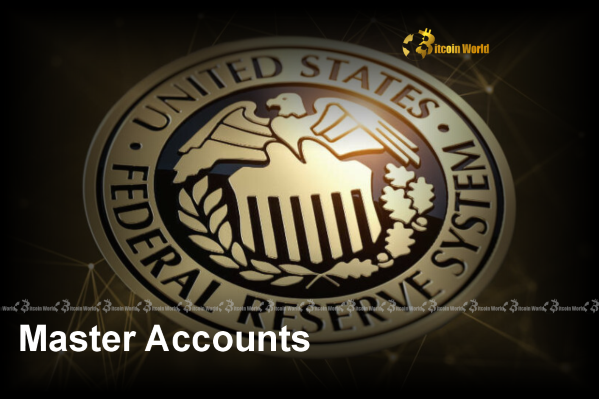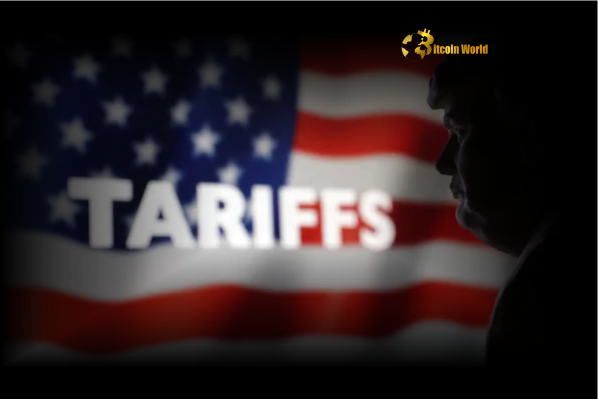BitcoinWorld

Crypto Firms Unlocking Breakthrough: The Quest for US Federal Reserve Master Accounts
A significant shift is underway in the American financial landscape as several prominent crypto firms are making a bold move to bridge the gap between the burgeoning digital asset economy and traditional central banking. The recent applications by WisdomTree Digital Trust, Standard Custody & Trust Company, and Commercium Financial for US Federal Reserve master accounts signal a potentially transformative moment for the industry. This pursuit of direct access to the central bank’s vital payment rails is more than just a procedural step; it represents a strategic maneuver that could redefine how digital assets interact with the broader financial system.
What Exactly Are Fed Master Accounts, and Why Do They Matter to Crypto Firms?
Before diving into the implications, let’s clarify what a Fed master account actually entails. Simply put, a master account at the US Federal Reserve is akin to having a direct bank account with the nation’s central bank. Traditionally, only commercial banks and certain government entities have been granted this privilege. It allows financial institutions to directly access the Fed’s services, including:
- Direct Access to Payment Systems: This means institutions can directly participate in critical payment systems like Fedwire (for large-value, real-time payments) and FedACH (for automated clearing house transactions). This is where the concept of payment rails becomes crucial, as it refers to the underlying infrastructure that facilitates the movement of money.
- Holding Balances at the Fed: Instead of holding reserves at a commercial bank, institutions with master accounts can hold their balances directly with the Federal Reserve. This offers ultimate safety and liquidity.
- Eliminating Intermediaries: Without a master account, a financial institution must rely on a correspondent bank (a commercial bank that has a master account) to access Fed services. This adds layers of cost, time, and potential risk.
For crypto firms, securing a Fed master account is a game-changer. It represents a significant step towards legitimization and integration into the core financial infrastructure. Imagine a world where digital asset transactions can settle with the same speed and finality as traditional bank transfers, bypassing multiple layers of intermediaries. This is the promise that master accounts hold for the evolving world of digital assets.
Who Are the Trailblazers Seeking Direct Access to the US Federal Reserve?
The three entities that have reportedly applied for these coveted accounts are not just any crypto companies; they represent different facets of the evolving digital asset ecosystem:
1. WisdomTree Digital Trust: WisdomTree is a well-established asset manager, known for its exchange-traded funds (ETFs). Their foray into applying for a master account through WisdomTree Digital Trust underscores a broader institutional shift towards embracing digital assets. Their move suggests a strategic vision to integrate digital asset products more seamlessly into traditional financial structures, potentially offering new forms of digital securities or stablecoins that leverage direct central bank access.
2. Standard Custody & Trust Company: As a qualified custodian for digital assets, Standard Custody & Trust Company focuses on providing secure and compliant storage solutions for institutional clients. Direct access to the US Federal Reserve’s payment rails would significantly enhance their operational efficiency and risk management capabilities, allowing for faster settlement of client funds and reducing reliance on third-party banking partners. This move highlights the growing need for robust, regulated infrastructure within the digital asset custody space.
3. Commercium Financial: While perhaps less widely known than the other two, Commercium Financial’s application signifies the ambition of newer entrants in the crypto space to build financial services on a foundation of direct central bank connectivity. Their pursuit of a Fed master account indicates a desire to operate at the highest levels of financial plumbing, potentially offering innovative payment solutions or financial products that require direct access to the national payment system.
These applications, while distinct, collectively paint a picture of a maturing industry seeking greater stability, efficiency, and regulatory clarity by connecting directly with the central bank.
What are the Benefits of Direct Fed Access for Digital Assets?
The implications of crypto firms gaining direct access to Fed master accounts are profound, offering a multitude of benefits that could reshape the financial landscape:
- Reduced Costs and Increased Efficiency: By eliminating correspondent banks, firms can significantly cut down on fees and operational costs associated with traditional banking intermediaries. This direct connection to the US Federal Reserve’s payment rails means faster, more efficient settlement of transactions.
- Enhanced Stability and Security: Holding funds directly at the central bank offers the highest level of safety and liquidity, mitigating counterparty risk inherent in commercial banking relationships. This provides a robust foundation for operations involving digital assets.
- Improved Liquidity Management: Direct access allows for real-time management of reserves and liquidity, crucial for firms operating in the fast-paced digital asset markets. This can prevent bottlenecks and ensure smooth, continuous operations.
- Legitimacy and Mainstream Integration: Gaining a master account confers a significant badge of legitimacy, signaling to regulators, traditional financial institutions, and the public that these crypto firms are operating within the established financial framework. This integration is vital for the broader adoption of digital assets.
- Innovation in Payment Systems: With direct access, these firms could potentially innovate new payment solutions that leverage both the speed of blockchain technology and the stability of central bank settlement. This could lead to more efficient cross-border payments, real-time settlements for various asset classes, and novel financial products.
How Has the US Federal Reserve’s Stance on Digital Assets Evolved?
The journey to this point has been anything but straightforward. Historically, the US Federal Reserve has maintained a cautious, if not skeptical, stance towards cryptocurrencies and digital assets, primarily due to concerns about financial stability, consumer protection, and illicit finance. However, the landscape has been steadily evolving.
In August 2022, the Fed issued its final guidelines for evaluating requests for master accounts and access to financial services, emphasizing a tiered review system based on an institution’s risk profile. While not explicitly mentioning crypto firms, these guidelines created a framework through which novel financial institutions could potentially apply.
The political climate also plays a role. The mention of potential changes under a Trump administration, which has previously considered granting digital asset companies direct access to Fed services, highlights the influence of executive policy on regulatory attitudes. While the Fed operates independently, the broader governmental push for innovation or a more accommodating stance towards digital assets can certainly influence the pace and nature of regulatory approvals.
This evolving stance indicates a recognition by the US Federal Reserve that digital assets are not a fleeting trend but a significant, enduring force that requires careful integration rather than outright rejection. The applications for Fed master accounts are a direct consequence of this shift, testing the waters of this new regulatory framework.
What Challenges and Hurdles Do Crypto Firms Face in This Pursuit?
While the prospect of direct Fed access is exciting, the path to obtaining a Fed master account is fraught with challenges. The US Federal Reserve‘s review process is notoriously rigorous and lengthy, designed to ensure the stability and integrity of the financial system. Crypto firms, given their relatively novel and often perceived higher-risk nature, face particular scrutiny:
- Regulatory Compliance: Applicants must demonstrate robust compliance with Anti-Money Laundering (AML), Know Your Customer (KYC), and sanctions regulations. For digital asset companies, proving the effectiveness of these controls can be more complex due to the pseudonymous nature of some blockchain transactions.
- Risk Management Frameworks: The Fed will meticulously examine a firm’s operational resilience, cybersecurity protocols, and overall risk management frameworks. Given the history of hacks and vulnerabilities in the crypto space, demonstrating a mature and comprehensive approach to risk is paramount.
- Financial Soundness: Applicants must prove their financial stability and ability to manage liquidity effectively. This includes meeting capital requirements and demonstrating sound financial practices.
- Political and Public Scrutiny: Granting master accounts to crypto firms is a politically sensitive issue. There may be pushback from traditional financial institutions, consumer advocacy groups, or lawmakers concerned about the risks associated with digital assets. Public perception and lobbying efforts can significantly influence the approval process.
- Defining ‘Novel’: The Fed’s guidelines include a category for ‘novel’ institutions, which crypto firms fall under. This requires a deeper, more tailored assessment, meaning the process can be prolonged as the Fed grapples with new business models and technologies.
These hurdles mean that even with applications submitted, approval is far from guaranteed and will likely take considerable time and ongoing dialogue with the Fed.
What Does This Mean for the Future of Digital Assets and Payment Rails?
The applications for Fed master accounts by crypto firms mark a pivotal moment in the convergence of traditional finance and the digital asset economy. If approved, these moves could trigger a cascade of developments:
- Increased Institutional Adoption: Direct access to central bank services would significantly de-risk institutional participation in digital assets, potentially drawing in more traditional financial players who have been hesitant due to infrastructure concerns.
- Evolution of Stablecoins: Firms issuing stablecoins could potentially hold reserves directly at the Fed, providing an unprecedented level of transparency and stability, effectively making them ‘Fed-backed’ in a practical sense. This could pave the way for a new generation of highly secure and trusted stablecoins.
- Faster, Cheaper Payments: The full integration of digital assets into the existing payment rails could lead to significantly faster and cheaper domestic and international payments, benefiting businesses and consumers alike.
- Regulatory Clarity and Frameworks: The process of evaluating these applications will inevitably push the US Federal Reserve and other regulators to develop clearer, more comprehensive frameworks for overseeing digital asset activities, leading to a more mature and regulated industry.
- Competitive Landscape Shift: Traditional banks might face increased competition from crypto-native firms offering more efficient and innovative services, prompting them to accelerate their own digital asset strategies.
This is not just about a few companies gaining an advantage; it’s about setting a precedent that could reshape the entire financial infrastructure, making it more agile, inclusive, and technologically advanced.
The Road Ahead: A New Era for Crypto Firms?
The applications by WisdomTree Digital Trust, Standard Custody & Trust Company, and Commercium Financial for US Federal Reserve master accounts represent a critical juncture for the digital assets industry. This strategic pursuit of direct access to the central bank’s core payment rails underscores a broader ambition for legitimization and seamless integration into the traditional financial system. While the path to obtaining a Fed master account is rigorous and fraught with regulatory, operational, and political hurdles, the potential benefits—from enhanced efficiency and reduced costs to increased stability and institutional adoption—are immense.
As the US Federal Reserve navigates its evolving stance on digital assets, the outcome of these applications will set a powerful precedent, shaping not only the future of these pioneering crypto firms but also the trajectory of financial innovation globally. This ongoing dialogue between the cutting edge of finance and its established bedrock promises a fascinating and transformative journey ahead.
To learn more about the latest crypto market trends, explore our article on key developments shaping digital assets institutional adoption.
This post Crypto Firms Unlocking Breakthrough: The Quest for US Federal Reserve Master Accounts first appeared on BitcoinWorld and is written by Editorial Team





